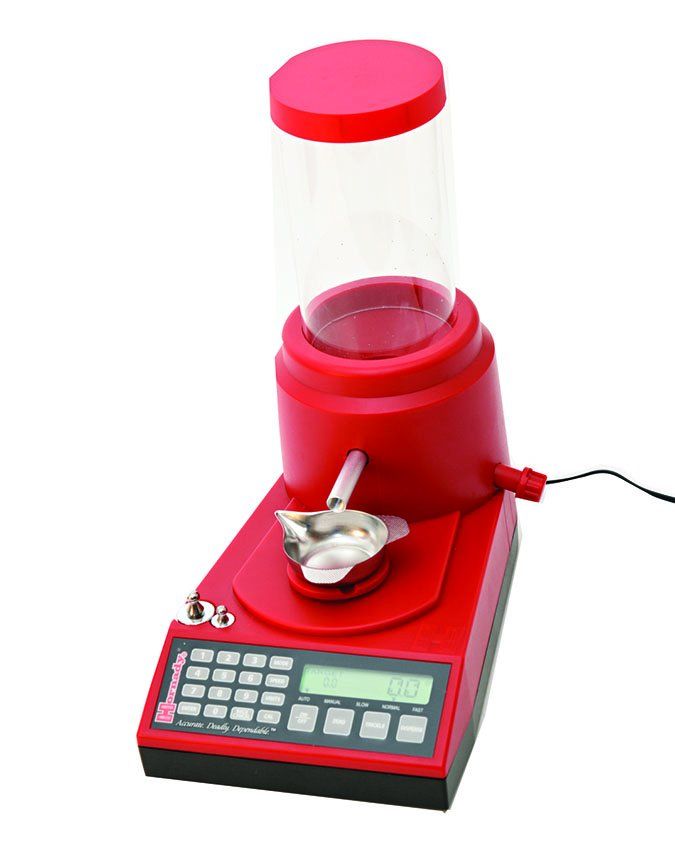
Our reloading pursuits for handguns are generally to provide volume ammunition for training at a discount based on reusable cases and bullets purchased in bulk. The progressive reloading press is capable of producing more rounds per hour than our arms can withstand. But setting the powder drop to exact quantities can be trial and error, a time-consuming exercise of repeated drops to prime the new setting and weigh out the result. But what if the new load is not what you hoped? Using a programmable automatic powder dispenser enables the reloader to quickly develop multiple loads for test without having to reset your powder measure.
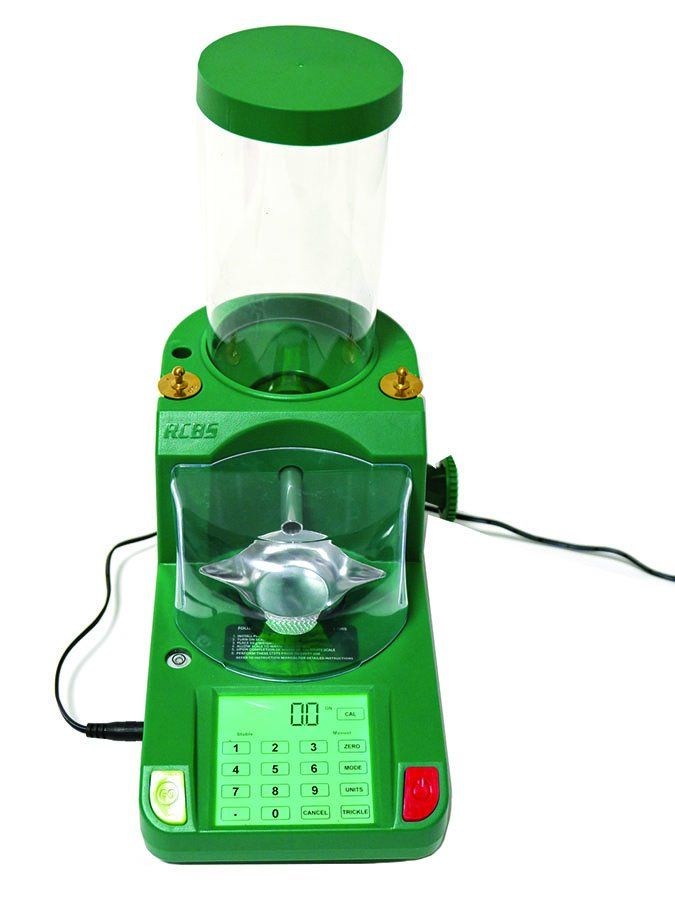
Automatic powder dispensers that drop a preset amount of smokeless powder have been around for a while. The powder charge is routed from its silo into a pan seated atop a scale. When the scale reads the desired preset weight, the stream of powder is shut off. The time saved is obvious but what about accuracy? Can the most fastidious reloader rely on an automatic powder dispenser to drop powder charges with the same accuracy as the common practice of using a manual powder drop to dispense a charge just a grain or two short of the desired load, then making up the rest of the charge by using a “trickler?”
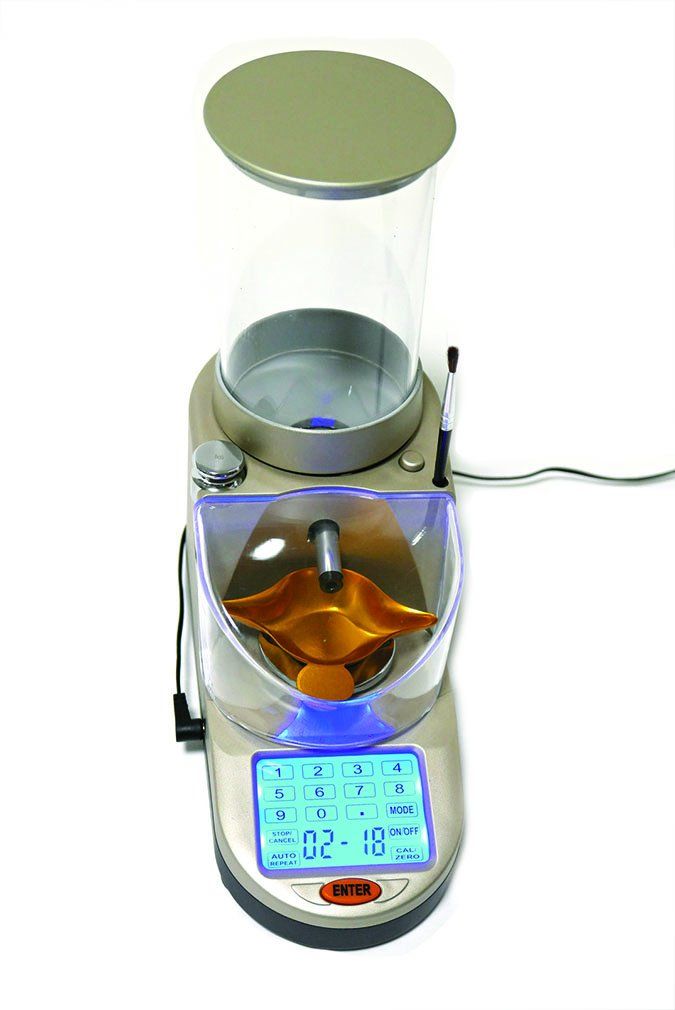
A trickler is a small tankard of powder across the top of which there is a pipe with a threaded interior. The center of the pipe has a pickup hole where it crosses through the powder. As the pipe is turned, granules of powder follow the thread to its end, where it tumbles one piece at a time into a pan seated atop a scale. Programmable automatic powder dispensers feed granules of powder through a threaded trickler pipe that rotates quickly until it gets close to the desired load, then slows to a ticking movement until the target weight is reached. We wanted to know if automation would save time and still maintain a high level of accuracy in our load development.
For tests we acquired Hornady’s $235 Lock-N-Load Auto Charge Powder Dispenser, Lyman’s $275 Gen6 Compact Touch Screen Powder System, and the $300 RCBS Chargemaster Lite. We challenged each machine to deliver a starting load for 40 S&W handgun and a starting load for 6.5 Creedmoor rifle. We asked each machine to drop 4.8 grains of Winchester Super Target (WST) smokeless powder for our handgun loads. Despite being listed as a ball powder, it was plain to see that each particle of WST appeared to be disc shaped.
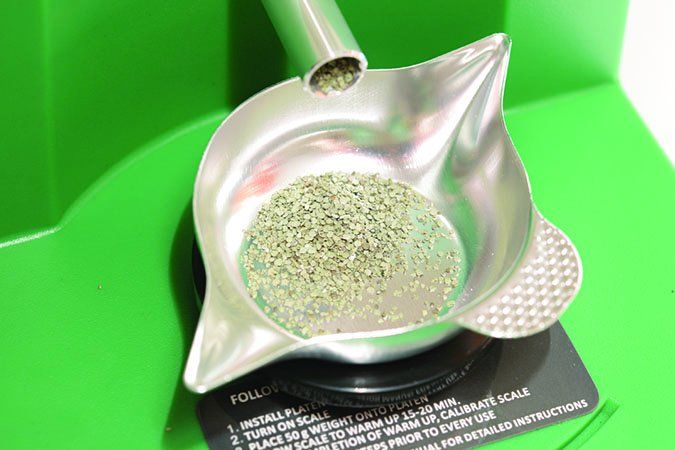
Next, we asked our machines to drop 40.2 grains of Accurate Reloader 17 (RL17) for our rifle rounds. Granules of RL17 resemble tiny lengths of a very fine single-filament wire, sometimes referred to as a “stick”-type powder. Our choice of powders was based strictly on our needs at the time, determined in advance of ordering our test units. We later learned that stick-type powders were among the most troublesome for use in automatic dispensers. The Lyman manual didn’t mention RL17 by name, but revealed that their machine was fit with a special adaptor for the fill tube when using such powders. In terms of cleanup, the RL17 powder was easier to evacuate than the granules of WST, which had greater surface area and a more porous texture that was slightly dusty. Given these factors alone, it looked like our three machines were in for a challenge.
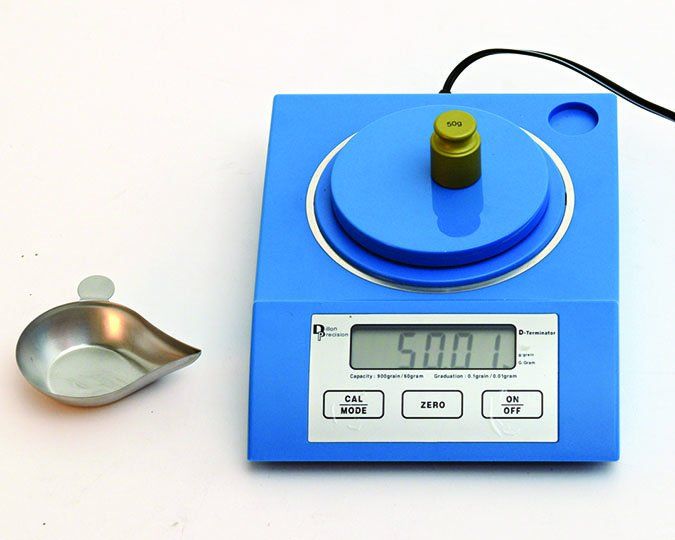
Throughout our tests we checked the weight of each dropped load of powder using a Dillon D-Terminator electronic digital scale, $140 from DillonPrecision.com. The Dillon scale, as well as our three test auto-dispensers, each carried an accuracy rating of +/-0.10 grains. Therefore,, we surmised that a reading of within 0.10 grains meant the scales were within spec, but if they were in complete agreement, so much the better. Aside from accuracy, we wanted to know how easy the machines were to setup and maintain. As prescribed in the owner’s manual, each machine was to be situated away from the vibration of our loading bench and cell phones were removed from the room. In addition, each unit was leveled and calibrated before use. Buyers of the Hornady and RCBS units were protected by a 1-year warranty. The Lyman warranty was listed as Limited Lifetime. Which programmable powder dispenser would perform the best? Let’s punch in some numbers and see what comes out.
Hornady’s Lock-N-Load Auto Charge Powder Dispenser No. 050068, $235
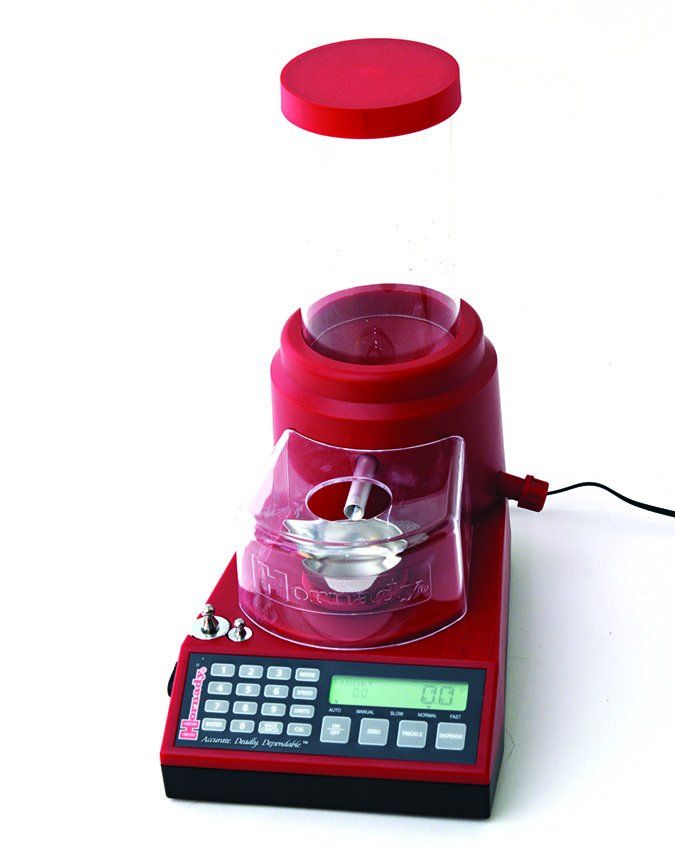
GUN TESTS GRADE: B
The Hornady Lock-N-Load can provide powder loads up to 300 grains in volume from its 1000-grain hopper. This unit provides Normal, Fast, or Slow fill speeds and loads can be dispensed manually, wherein the desired weight is entered before each delivery, or the machine can be set to begin automatically. In automatic mode, returning the pan to its place on the scale began the delivery system after a brief delay (about 2 seconds), during which the scale returned to zero. When the scale read zero, the delivery tube started turning first at a high rate of speed, then it slowed to a series of ticks until the prescribed weight was reached. Then, the fill tube stopped rotating and the unit emitted a beep sound.
To drain the powder silo, we rotated the cap on the spout protruding from the right side of the unit. The spout was small and the plastic used made the action sticky as we aligned the relief in the cap with the hole in the spout. Powder remaining in the drainage area was ushered down through the spout using the supplied brush. Then we turned on the machine to route the powder remaining from the fill tube. We found this unit was prone to static cling, and we had to manually wipe out the removable cylinder that served as the walls of the powder silo.
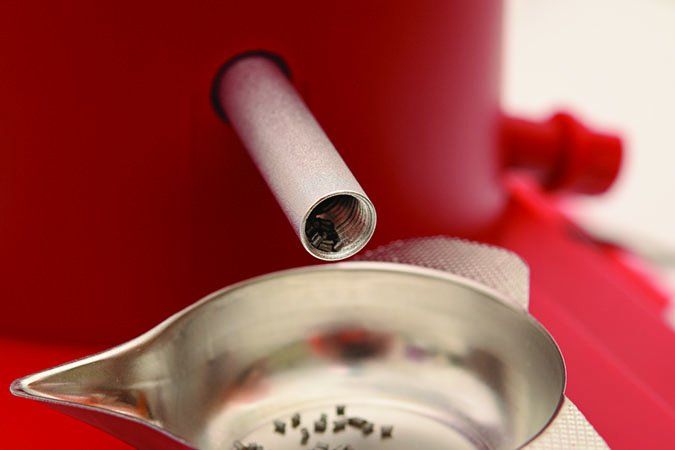
The feet on the Lock-N-Load were non-adjustable, so we used business card stock to level the unit. Calibration was achieved in about 6 steps that go by quickly. (Readouts can be expressed in either grains or grams.) Two test weights were supplied, weighing 10 grams and 50 grams respectively, which were used in turn until the pan is replaced and zeroed out. The two test weights are stored in cubbyholes integral within the unit body. The rate at which the fill tube ticks can be adjusted, as well as when during the fill cycle it switches from constant rotation to trickle mode. Loading the device with Winchester Super Target, we timed each of the dispensing rates as delivered. The Hornady was able to deliver 4.8 grains of WST in 17 seconds in the fast mode, 35 seconds in the normal mode, and 50 seconds at the slowest rate of speed. We tried adjusting both the trickling speed and the trickling start time, but we didn’t find any real difference in performance.
In terms of accuracy in 10 trial drops (at normal speed), the Hornady Lock-N-Load registered a payload of 4.8 grains with the Dillon D-Terminator in agreement six times. Three times the Dillon scale disagreed, reading 4.7 grains, and reported a weight of 4.6 grains once. Filling the pan with granules of Reloder 17 was faster because the little round pieces rolled freely without any attraction between each piece. But this also affected accuracy and cleanup because the gauge of the threads inside the fill spout were large and coarse, trailing off without any additional help to meter individual granules.
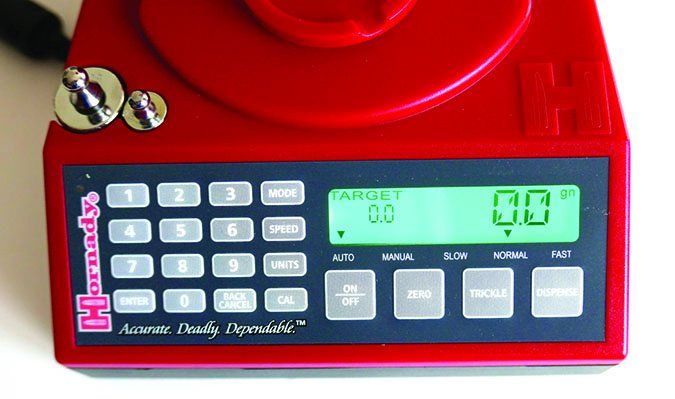
Any vibration to the unit, including setting down the pan without caution or replacing the top on to the powder silo, was likely to dislodge a piece of powder from the fill tube. Gentle operation of the keys on the control panel, which were manually driven but sealed within a bubble, was required to prevent shaking loose bits of powder that were staged at the end of the fill tube.
Our 10-round accuracy test dispensing the RL17 resulted in the Dillon scale agreeing with the Hornady Lock-N-Load three times. Five times the Dillon registered a reading of 40.1 instead of 40.2. Twice the powder dispenser indicated an overage, wherein the dropped load was more than 0.10 grains over, registering 40.4 grains and 40.7 grains on the Dillon scale. In an effort to improve performance, we contacted Hornady Product Support by telephone, and the representative was able to walk us through resetting trickle speed and the time interval before the machined began the trickle process. In addition, we were supplied via email an updated manual for machines with serial numbers above SN 2840. However, over the course of repeated tests, the performance of our unit remained largely unchanged.
Our Team Said: The best-looking unit in our tests was also the least accurate. We found the control buttons to be awkward and the “reasoning” of the unit to be inconsistent. The updated information sent to us by Hornady’s support staff was helpful specifically in showing us how to change modes quickly and reset the machine after an overcharge. But overall performance was nevertheless only slightly improved. Our conclusion was that the Lock-N-Load’s ability to accurately dispense different types of powder granules was limited.
RCBS Chargemaster Lite No. 98940, $300
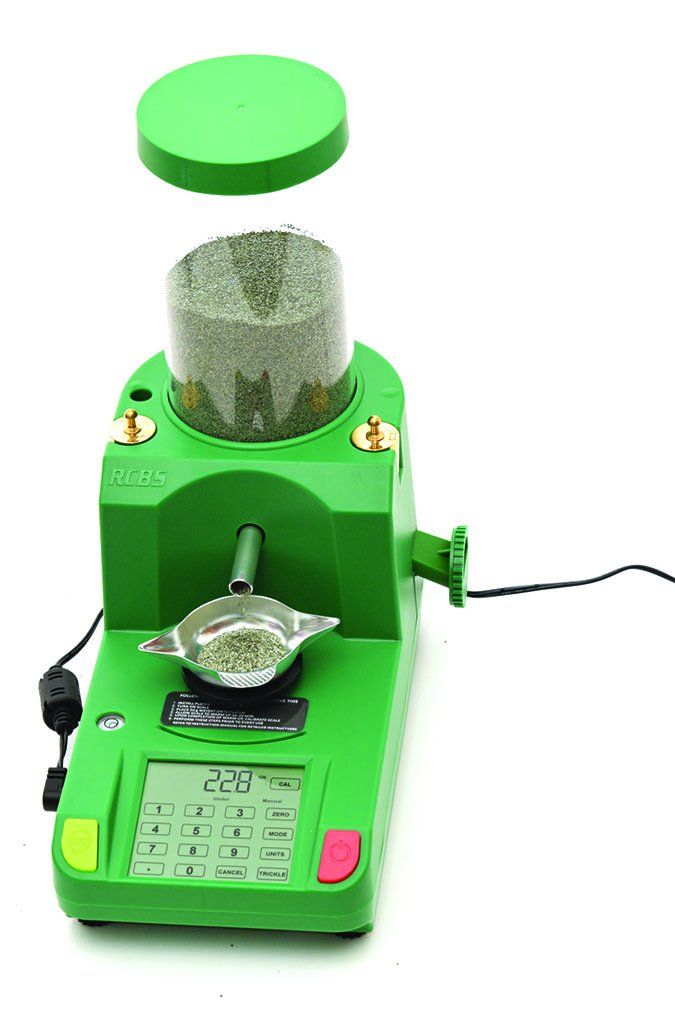
GUN TESTS GRADE: A
The RCBS Chargemaster Lite sounds as though it should be a small machine, but this was a full-sized unit with 2000-grain capacity and able to dispense up to 300 grains of smokeless powder at a time. Special features included a quick-drain spout, independently adjustable feet at all four corners to take advantage of the built-in bubble level, and an LCD touch-screen display. The Go button and the on/off buttons located at either side of the unit body were not touch-screen features.
After turning on the machine and letting it warm up, the calibration protocol was a seven-step process utilizing two 50-gram weights that are stored to either side of the silo when not in use. Readouts on the screen walked us easily through the process. We liked the way information on the screen was organized. The numbers were large and easy to read. Prompts at the bottom of the screen were in small print, but nonetheless clear and concise.
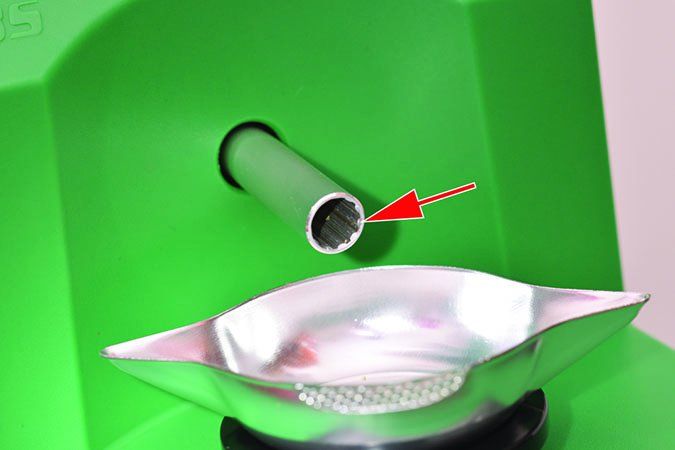
Left to right, the prompts read Stable, for when the scale is ready to measure, Over indicating more weight than was requested, and Under for too little weight in the pan to match the request. The designations for Auto-Dispense and Manual modes also appeared along the bottom line of the screen. The Manual mode allowed the user to trickle the powder as long as the dispense key is in contact. The Auto-Dispense mode begins rotation of the filler tube as soon as the pan is in place and the scale has stabilized. Rotation continued until the scale registered the desired weight. There was a third mode referred to as Dispense for filling the pan one load at a time. Dial in the desired load and press the go button.
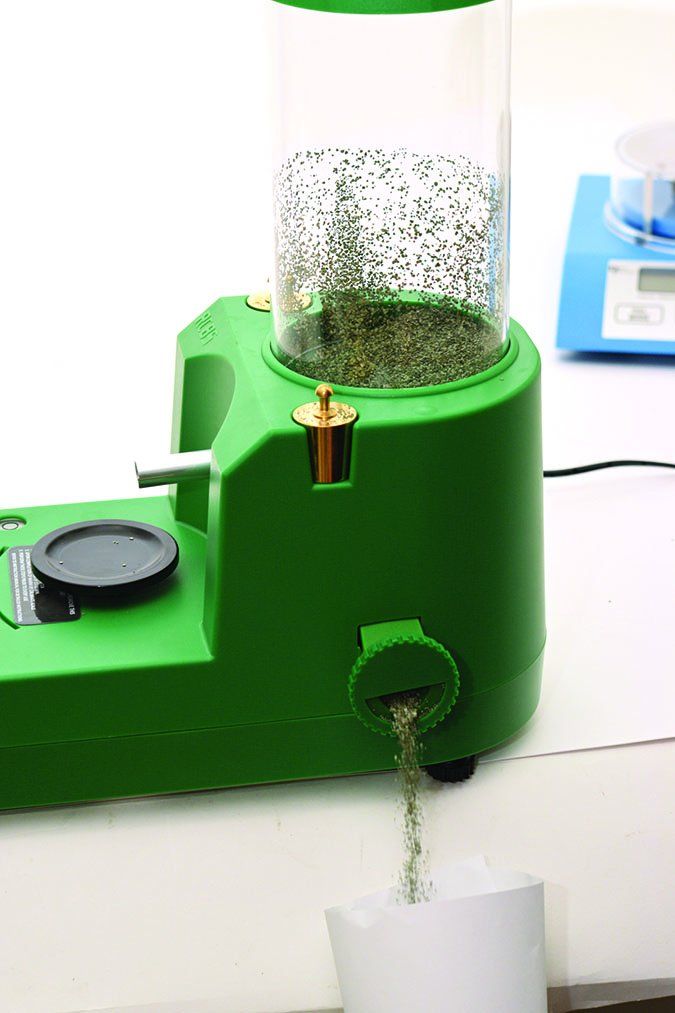
We found that the quick-drain feature was just that. Featuring a larger opening than the Hornady and smoother operation, rotating the drain spout one-half turn dumped powder from the silo quickly. But we still had to follow up with brushing out the interior, and the clear plastic silo needed to be wiped out. All three manufacturers recommend not leaving powder in the machine. Not just for safety reasons, but also the longer you leave the powder in place, the more susceptible it becomes to static cling, making it more difficult to clean.
Loading the Chargemaster Lite with Winchester Super Target, we punched in 4.8 grains. Over the course of ten tries, a comparison between readings on the RCBS scale and the Dillon scale told us that the two units agreed completely 7 out of 10 times. Three times the Dillon scale read only 4.7 grains, but given each unit is rated for accuracy at +/- 0.10, the RCBS was in spec.
Setting the RCBS to dispense 40.2 grains of Reloder 17 powder, we were rewarded 10 out of 10 times with quantities of powder that weighed the same when checked on our Dillon scale, with no overages. Asking ourselves why the RCBS was so much more accurate than the Hornady when dropping the RL17 powder, we took a careful look at the machine. What we discovered was that the threads that siphoned the powder through the filler tube did not continue all the way to the edge of the tube. Just before the end of the tube, the spiral of threads stopped. The distance from the threads to mouth of the fill tube instead showed deep lines running parallel to the bore. Evidently, when the granules arrived at the end of tube, they were separated and organized by the grooves running back to front.
Our Team Said: The RCBS Chargemaster Lite proved to be an accurate, well-thought-out machine that did what it was supposed to. That is, it makes higher-volume powder delivery more convenient for the operator. The touch screen was responsive without being overly sensitive, and the information was clearly illustrated. Clean up was easy, and the specially configured fill tube kept things clean.
Lyman Gen6 Compact Touch Screen Powder System No. 7750550, $275
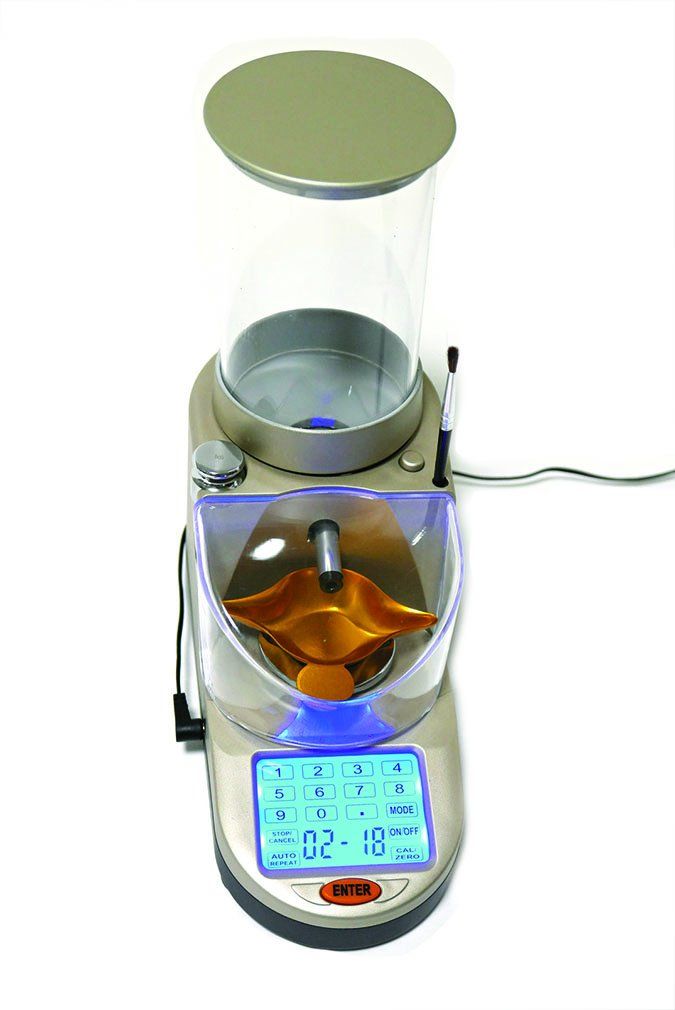
GUN TESTS GRADE: C
The Lyman Gen6 Compact is like the name implies — a smaller unit than either the Hornady or RCBS machines, and it was developed to take up less space than Lyman’s Gen5. The maker chooses not to list powder capacity due to the differences in powder configuration, but the removable clear-plastic cylinder was about 1 inch shorter on average than the other units. All three cylinders measured about 3.1 inches across. The Gen6 offered a true touch screen aside from the Enter button that is used to start the loading process in manual dispense mode. The Gen6 had the fastest warm-up time of our three loaders, with the screen counting down from 3 minutes after it had been turned on. It also had the shortest, most convenient calibration procedure consisting of five easy steps. Lyman reports they put a lot of time into making the unit invulnerable to interference from cell phones and computers. Being able to utilize the unit in the vicinity of a cell phone or computer is advantageous because downloading information via Bluetooth from a chronograph for example, is becoming more commonplace.
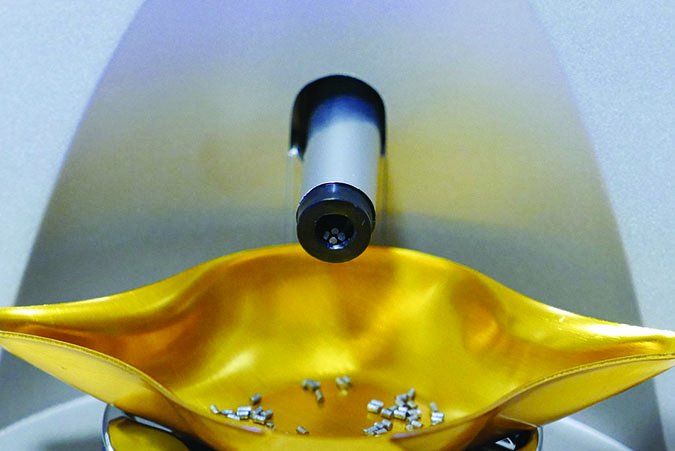
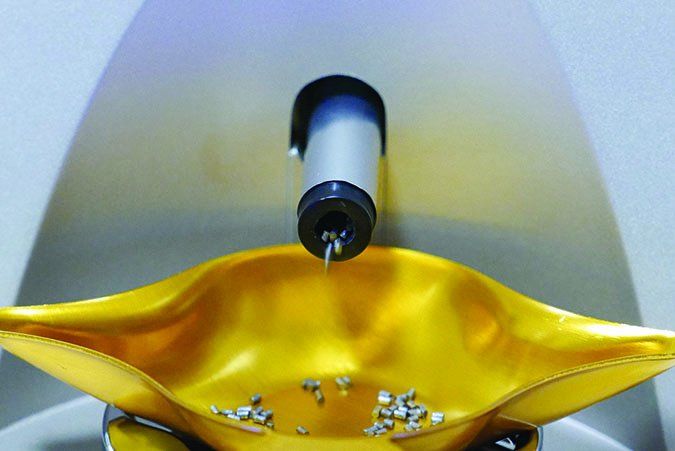
Emptying the Gen6 was at least as quick as the RCBS machine. The right side of the unit body featured a trapdoor that folded down to expose the release gate and act as a chute. The advantage was you didn’t have a flow tube sticking out, so the machine maintained a trim profile. But the chute did not lock into the down position. In contact with a funnel, it was prone to trying to shut while powder flowed from the drain. We think this resulted in granules of powder being leaked into the unit body.
Unlike the other units, the Gen6 can be disassembled and cleaned internally. The fill tube, which turned like an axle, was seated across a removable component referred to as the “fill box.” The base of the silo was removable and played a part in seating the fill box. Remove the base and the fill box could be slid through the right side of unit body. This allowed for a more thorough cleaning. Whereas powder stored inside the Hornady and RCBS units had only two paths, out the fill tube or down the drain, much of the interior of the Gen6 was unsealed. While Lyman did their homework when it comes to reducing static cling, we found that even when the machine appeared to empty and clean, loose powder could find its way into the unit body in and around the fill box. Keeping the interior of the machine free of loose powder was imperative to assure safety.
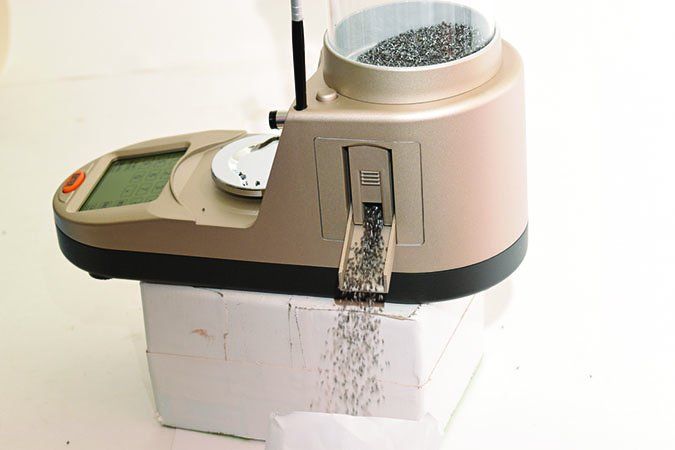
The Gen6 will deliver powder measured in grams, grains, or ounces. The system works in only one speed, and Lyman claims it will dispense at a rate of 2 grains per second. Actual speed of delivery, in our opinion, depends on the configuration of the powder, but it was fast. Asking for 4.8 grain of WST, the unit filled the pan to specification in just 14 seconds in the Auto-dispense mode. The elapsed time began when placing the pan on the scale. There was a brief delay of little more than one second and the fill tube began rotating. Actually, there is a caveat here. The Gen6 arrived with a limiter nozzle that screwed into the end of the flow tube. The limiter was designed to enhance the accurate metering of powders, such as our other test powder Accurate Reloder 17. The RL17 powder rolled around freely, unlike the WST that appeared to be a pile of discs that offered a degree of resistance. Filling the pan with 4.8 grains of WST was 6 seconds slower per fill, taking an elapsed time of 20 seconds.
We actually preferred using the limiter no matter what powder we were loading for the following reasons. First, it’s a small part easily lost, and keeping it in place was the best way to keep track of it. In addition, it’s not uncommon to hit the fill tube or shake any of these machines when removing or replacing the pan. This results in granules of powder dropping from the fill tube. The limiter greatly reduced this problem. As seen above, the difference in fill time was minimal, and we think it is reasonable to assume the limiter should enhance metering for all types of powder.
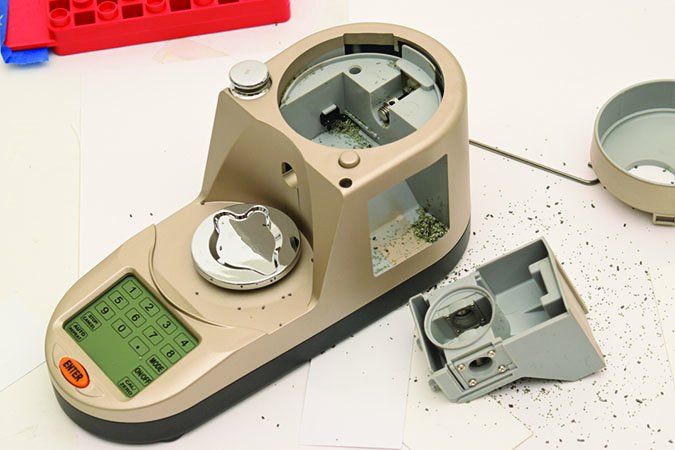
Finally, the limiter did assist in addressing a problem with the Gen6 that we think is characteristic of how the fill tube connects to the drive shaft. Though stabilized by two bearings in the fill box, the tube was connected by a fitting that was actually a tightly wound spring. This allowed the threaded connector to float. We’re not sure why the drive shaft was not solidly mounted, but the result was the fill tube rotated with a small degree of wobble. Making sure the fill box was properly seated reduced the wobble of the fill tube, but did not eliminate it completely. As a result, the fill tube seemed to move up and down slightly as it rotated.
Nevertheless, we think the limiter helped minimize excessive metering. Working in the manual mode, pushing start after entering the desired load, the Gen6 delivered a powder charge that weighed out on both the Gen6 and our Dillon scale 7 out of 10 times at the requested 4.8 ounces. Three times the Dillon indicated the drop was 0.10 grains short. Switching to Auto-dispense mode, the two scales agreed 10 out of 10 times.
Loaded with RL17 powder, the manual dispense mode proved more accurate. The Gen6 scale read the requested amount of 40.2 grains had been fulfilled nine times, but indicated a drop of 40.3 grains once. The Dillon scale read the same as the Gen6 every time. In auto-dispense mode the two scales agreed that the Gen 6 had dropped 40.3 grains on one fill and 40.5 grains on another fill. Another drop registered 40.4 on the Gen6 and 40.2 on the Dillon. One more drop showed a variance of 40.2 on the Gen6scale and 40.3 on the Dillon. Both units agreed on the remaining six drops.
Our Team Said: We liked operating the Lyman Gen6, and it was on the way to receiving a very high rating. Our only gripe had been that we think the machine could just as well have been perfectly accurate if the fill tube stayed level throughout its rotation. That there was a difference in delivery between the Auto and Manual modes remains a mystery. But in trickle mode, the wobbling motion of the fill pipe did appear to show a collection of granules on the up swing, while throwing multiple pieces of powder on the downswing. Our bigger disappointment came when we realized it was not a sealed unit and powder could be trapped beneath the fill box without any telltale signs to warn the operator. Removing the fill box we found a large residue of both powders piling up inside the unit body, even though from the exterior it appeared to be clean and empty. Even if this was by way of our own carelessness, this could not have happened with the other machines because the only path stored powder could follow inside the Hornady or RCBS products was out the fill tube or down the drain. Curious, we turned the unit over and tapped the Gen6 on our bench (not recommended for maintaining the electronics). More powder dropped out from crevices we had no way to access.
Written and photographed by Roger Eckstine, using evaluations from Gun Tests team testers.





























The $35 Lee AutoDrum is remarkable. I use a scale that reads to 0.01 grains and have seen it throw 3.22gr of Titegroup one after the other (on a Lee Loadmaster)
While that is a east-to-meter powder the scale is worthy of consideration.
I like Hornady Powder despenser. How can I buy ?